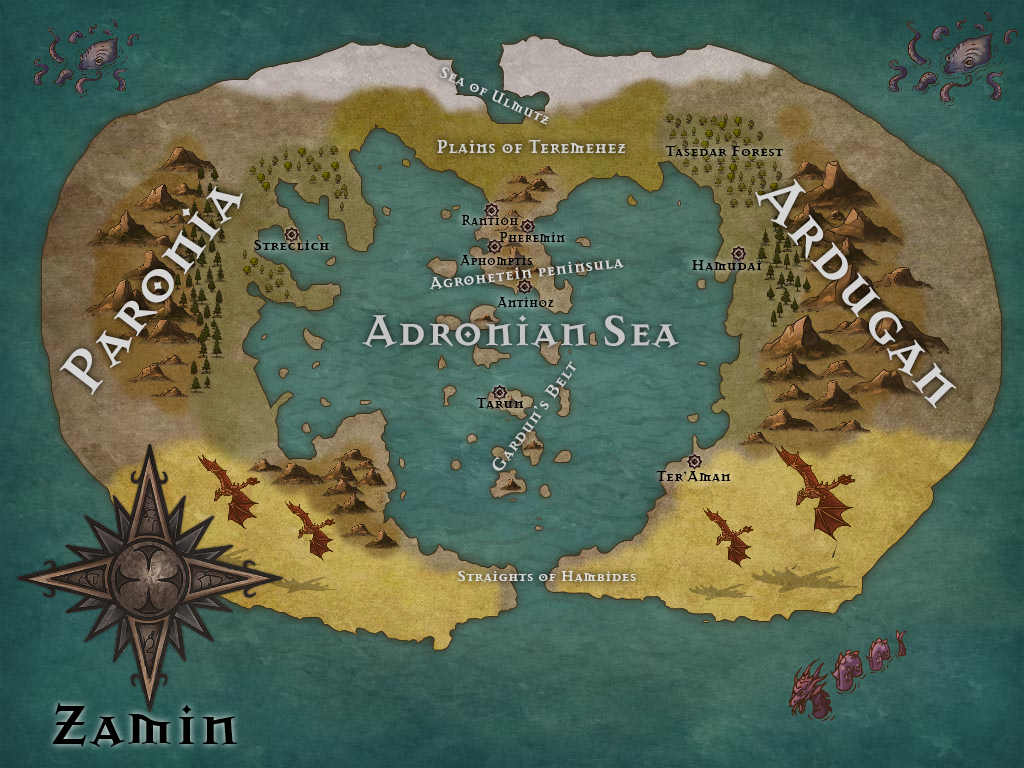OPO1
"I could not believe my host's eyes for a long time. Everywhere I looked, the land disappeared! It did not curve upwards as it should! After some exploring and experimentation I reached the conclusion that land here curves downwards, the reverse of what is normal. That is why when a ship sails in the distance its hull first disappears and then its mast."
-Boundary Walker Hakuan Brestelveri Sar, the Scientist
Geography
The surface of Outer Plane Object 1, or OPO1, is where most portals from the Inner Plane connect. Sapient inhabitants do not have a proper name for it, using instead the names of earth or sand to refer to it, with the most proper translation being Zamin. It is a sphere, estimated at 11 thousands kilometers in diameter. Objects are pulled towards the middle of the sphere and are stopped by the ground from falling. Estimates suggest a surface consisting of 78% deep ocean, 5% shallow seas and lakes and 17% land. A layer of atmosphere of around 10 km covers the surface composed mainly of elements 7, 8 and 18.
Two major landmasses dominate it - the continents of Ardugan and Paronia. Between them lies the Adronian Sea, which contains numerous smaller landmasses. Around the two continents lie vast masses of water, differentiated as the Great Ocean and Northern Ocean.
Above, one first notices two peculiar objects. Visible for about half the time is a glowing circle, called OPO2 or in one local language translation - Sun, which if looked upon too long without protection will cause the loss of sight in the human host. When visible, it illuminates the surroundings greatly, causing changes in the weather. The other object, OPO3, has a rather odd pattern of appearance but it mostly behaves as OPO2 as in being visible half the time. It is called Moon and appears as a white circle of white rock and, when OPO2 is not visible, sometimes dimly illuminates the environment.
When OPO2 is not visible, multiple glowing objects can be seen above. Some of these move with an odd but uncanny regularity. All objects above have been classified as OPO 4 to 6374. Further research is required.
Fauna & Flora
Life inhabits the thin layer of the surface in four major forms: bacterial, plant, fungi and animal, all with the exception of the plant forms bear resemblance to the lifeforms of the Inner Plane. Sapience is encountered in the animal forms as the primate species humans and ogrid and the archaosaur species drako.
Plant life is of the most interest as it has a unique interaction with OPO2. When it is visible, plant lifeforms undergo a process of feeding and growth, involving air, water, soil and the light of OPO2. Animal, fungi and bacterial life feed upon plant life and upon each-other, thus it can be surmised that plant life is at the base of the food-chain. A question of particular interest then arises of why don't other life forms also use the light of OPO2 to feed.
Animal lifeforms come in different conformations, but as the size of the species grows, a particular model can be observed: bilateral symmetry, four limbs, a head with mouth, nose, two eyes and two ears and sometimes a tail. Of the sapient species all follow this model.
The most common sapient animal is the human, which is tail-less, mostly bare-skinned and has an adult height of around 1 meter and 65 centimeters. They are the only lifeform that can be used as a vehicle for Boundary Walkers. The next one is the ogrid, which resembles the human, but their adult height varies greatly across subspecies from 1 meter and 20 centimeters up to 3 meters and 50 centimeters. The last sapient animal is the drako which has a tail. It's front limbs double as wings, which are covered in feathers, as are its back and tail, leaving the rest covered in scales. While there are no subspecies, their size varies instead greatly with age, as they seem to not have a set adult size, instead growing indefinitely up to a measured record height of 12 meters from head to tail and a 14 meter wingspan.
Natural Resources
While most elements and mixes of elements can be found in the ground, on the surface and even in the lifeforms themselves, the greatest resource of OPO1 is the apparent access to other Outer Plane Objects. Gravity currently constrains everything close to the surface of OPO1, thus lengthy research in many fields will be required before making use of this resource.
Map created using inkarnate.com
Remove these ads. Join the Worldbuilders Guild










Wow. That's all I have to say. You should come to the WA Discord server and utilize the #worldbuilding-review channel (be sure to read the rules first though). I needed a moment to realize that you were talking about the planet from an outside perspective, but as soon as I got it I was flashed by how well you got into this perspective. Also, great integration with the rest of your articles, especially the boundary walkers. My question for you is (and think carefully about it before answering): What colors do OBO2 and the sky of OBO1 have?
Thanks, I will. Kinda busy with an upcoming exam, otherwise I would have also added formatting and drawings. OPO1 is supposed to be Earth-like with a normal Sun and Moon (but it seems utter alien for beings who came from a pocket dimension who don't even know what a sky is) and is inhabited by human civilizations in the early Antiquity. It is meant to explore the transition from human tribal societies to slave societies (which I assume must have been quite traumatic for people to experience). But alas, in-depth writing might have to wait for after the exam.